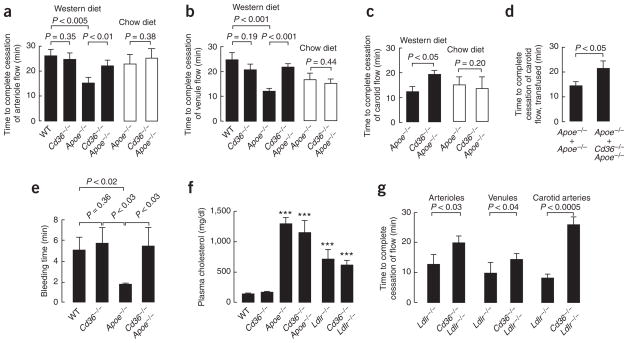Figure 1.
CD36 plays a role in thrombosis in vivo in the setting of hypercholesterolemia. (a–c) Mice of the indicated genotypes were maintained on Western diet (solid bars) and then used for an intravital thrombosis assay. Mesenteric arterioles (a) or venules (b) or carotid arteries (c) were visualized, and in vivo thrombosis times were measured as described in Methods. Mice on chow diet (empty bars) were analyzed in the same way, except that FeCl3 exposure times were increased by 1 min. Data are presented as mean ± s.e.m. for n ≥ 7 for chow diet and n ≥ 8 for Western diet. (d) Apoe−/− mice and Apoe−/− Cd36−/− on a Western diet were depleted of platelets by γ-irradiation, subsequently injected with platelets from either Apoe−/− mice (n = 5) or Apoe−/− Cd36−/− mice (n = 5) and the carotid artery occlusion test was performed as described in Methods. (e) Tail vein bleeding assay was performed as described in Methods. Data are presented as mean ± s.e.m.; numbers of mice used are: wild-type (n = 8), Cd36−/− (n = 5), Apoe−/− (n = 4) and Cd36−/− Apoe−/− (n = 4). (f) Total plasma cholesterol concentration is presented as mean ± s.d. mg/dl for at least 6 animals with the indicated genotype on a Western diet. ***P < 0.001 by t-test as compared to wild-type. (g) Indicated groups of mice were fed a high-cholesterol diet as described in Methods, and in vivo thrombosis times were assessed as in a–c. n ≥ 7 animals in each group. See Supplementary Methods for details.

